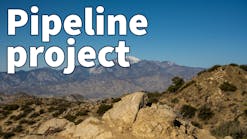As manager of engineering for the water distribution division of the nation’s largest municipal utility—the Los Angeles Department of Water & Power (LADWP)—Steven Cole has his work cut out. Los Angeles is experiencing unprecedented growth: high-rise development, a less than 1% industrial property vacancy rate, potential Olympics hosting, metropolitan construction, a multi-billion dollar LAX improvement project, and revitalization of streets and communities. Supporting the water distribution network requires an asset management program, infrastructure replacement, and exploring technologies for a safe, long-lasting, resilient system.
Cole was a project engineer on the construction of two 30-million gallon underground water storage tanks. Another project to cover the Los Angeles Reservoir, which holds 3.3 billion gallons of potable water in a seismically active area, saved millions of dollars by utilizing hollow HDPE balls to create a flexible cover that keeps birds off the water surface, prevents evaporation, reduces algae formation, and reduces chemical treatment.
Despite recent record-breaking snowfall in California’s mountains, the LADWP remains vigilant about drought, identifying water losses to reduce the system’s 5% loss rate. Efforts include researching technology to recirculate water within the pipe network when water lines are flushed or disinfecting instead of discharging water to the storm drain or sewer, testing leak detection technologies to identify smaller leaks, and testing pressure sensors to identify pipe network pressure surges.
Cole, a California native, always considers earthquake potential. A field engineer with repair crews in the Northridge Earthquake aftermath, he saw the type of damage that occurs and how it could be minimized. LADWP is the first US utility to install ductile iron seismic-resistant pipe, used for years in Japan “and purportedly has survived a variety of calamities with no leaks,” says Cole. “Our plan is to develop a seismic-resilient backbone system to keep water in critical pipes after an earthquake and minimize or eliminate leaks.” LADWP also is testing new communication equipment in the field to provide real-time, cloud-based asset information for field crews handling leaks to increase safety and efficiency, enable faster shutdowns, and automatically prepare documentation.
What He Does Day to Day
Meetings consume most of Cole’s time, as he leads 90 employees, providing engineering support to 675 field personnel and a customer interface to developers. Cole manages the engineering of one of LADWP’s largest infrastructure replacements. The aging infrastructure was highlighted by the Sunset/UCLA water main blowout that resulted in a 20 million gallon water loss. Los Angeles’ mayor and residents supported a rate increase to double the pipe replacement rate from 150,000 to 300,000 feet within five years.
What Led Him to This Line of Work
As a child, Cole enjoyed creating dams in the gutter during rainstorms or racing the tide at the ocean to build sandcastle berms and trenches to convey water away from the structure. He earned a B.S. in civil engineering from the University of California at Irvine and an M.S. in water resources from the University of Southern California. Cole was drawn to work for LADWP by the variety and magnitude of work: 7,200 miles of pipe ranging in diameter from 4 to 144 inches, four million customers, more than 130 tanks and reservoirs, and one of the nation’s most complicated supply and distribution systems.
What He Likes Best About His Work
The 1994 Northridge Earthquake was a turning point for Cole. Halfway through working 20-hour days for two weeks, Cole was refueling a department vehicle at a gas station when a man shook his hand and thanked him for his work because up until that point he didn’t appreciate the importance of water, like many members of the public who take it for granted. “In a situation like an earthquake, you suddenly have no water available to shower, flush toilets, or brush teeth. I’ve got to be worried about the water quality. That motivated me to work hard for the rest of my career for Los Angeles ratepayers.”




